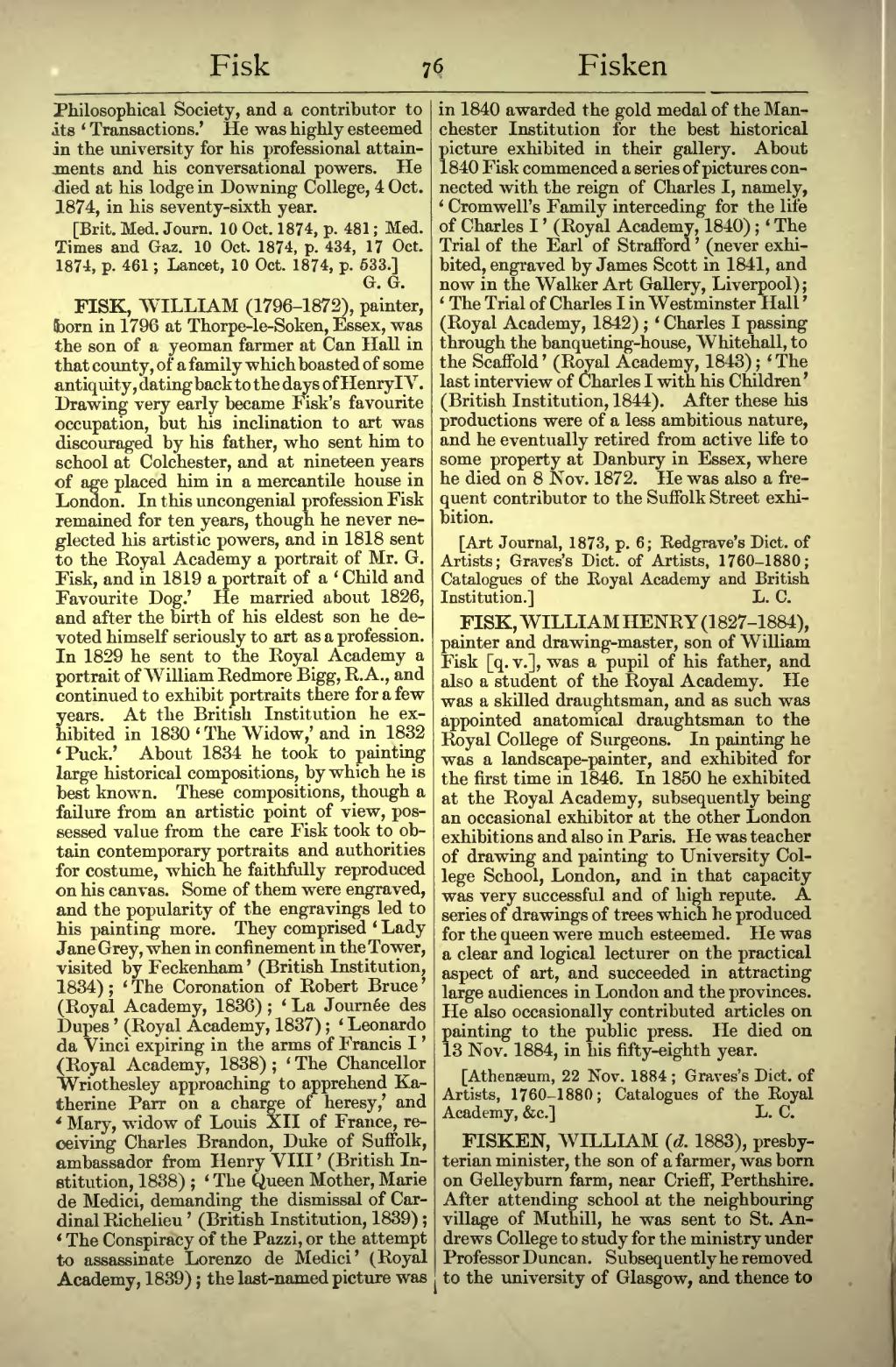Philosophical Society, and a contributor to its 'Transactions.' He was highly esteemed in the university for his professional attainments and his conversational powers. He died at his lodge in Downing College, 4 Oct. 1874, in his seventy-sixth year.
[Brit. Med. Journ. 10 Oct. 1874, p. 481; Med. Times and Gaz. 10 Oct. 1874, p. 434, 17 Oct. 1874, p. 461; Lancet, 10 Oct. 1874, p. 533.]
FISK, WILLIAM (1796–1872), painter, born in 1796 at Thorpe-le-Soken, Essex, was the son of a yeoman farmer at Can Hall in that county, of a family which boasted of some antiquity, dating back to the days of Henry IV. Drawing very early became Fisk's favourite occupation, but his inclination to art was discouraged by his father, who sent him to school at Colchester, and at nineteen years of age placed him in a mercantile house in London. In this uncongenial profession Fisk remained for ten years, though he never neglected his artistic powers, and in 1818 sent to the Royal Academy a portrait of Mr. G. Fisk, and in 1819 a portrait of a 'Child and Favourite Dog.' He married about 1826, and after the birth of his eldest son he devoted himself seriously to art as a profession. In 1829 he sent to the Royal Academy a portrait of William Redmore Bigg, R. A., and continued to exhibit portraits there for a few years. At the British Institution he exhibited in 1830 'The Widow,' and in 1832 'Puck.' About 1834 he took to painting large historical compositions, by which he is best known. These compositions, though a failure from an artistic point of view, possessed value from the care Fisk took to obtain contemporary portraits and authorities for costume, which he faithfully reproduced on his canvas. Some of them were engraved, and the popularity of the engravings led to his painting more. They comprised 'Lady Jane Grey, when in confinement in the Tower, visited by Feckenham' (British Institution, 1834); 'The Coronation of Robert Bruce' (Royal Academy, 1836); 'La Journée des Dupes' (Royal Academy, 1837); 'Leonardo da Vinci expiring in the arms of Francis I' (Royal Academy, 1838); 'The Chancellor Wriothesley approaching to apprehend Katherine Parr on a charge of heresy,' and 'Mary, widow of Louis XII of France, receiving Charles Brandon, Duke of Suffolk, ambassador from Henry VIII' (British Institution, 1838); 'The Queen Mother, Marie de Medici, demanding the dismissal of Cardinal Richelieu' (British Institution, 1839); 'The Conspiracy of the Pazzi, or the attempt to assassinate Lorenzo de Medici' (Royal Academy, 1839); the last-named picture was in 1840 awarded the gold medal of the Manchester Institution for the best historical picture exhibited in their gallery. About 1840 Fisk commenced a series of pictures connected with the reign of Charles I, namely, 'Cromwell's Family interceding for the life of Charles I' (Royal Academy, 1840); 'The Trial of the Earl of Strafford' (never exhibited, engraved by James Scott in 1841, and now in the Walker Art Gallery, Liverpool); 'The Trial of Charles I in Westminster Hall' (Royal Academy, 1842); 'Charles I passing through the banqueting-house, Whitehall, to the Scaffold' (Royal Academy, 1843); 'The last interview of Charles I with his Children' (British Institution, 1844). After these his productions were of a less ambitious nature, and he eventually retired from active life to some property at Danbury in Essex, where he died on 8 Nov. 1872. He was also a frequent contributor to the Suffolk Street exhibition.
[Art Journal, 1873, p. 6; Redgrave's Dict. of Artists; Graves's Dict. of Artists, 1760-1880; Catalogues of the Royal Academy and British Institution.]
FISK, WILLIAM HENRY (1827–1884), painter and drawing-master, son of William Fisk [q. v.], was a pupil of his father, and also a student of the Royal Academy. He was a skilled draughtsman, and as such was appointed anatomical draughtsman to the Royal College of Surgeons. In painting he was a landscape-painter, and exhibited for the first time in 1846. In 1850 he exhibited at the Royal Academy, subsequently being an occasional exhibitor at the other London exhibitions and also in Paris. He was teacher of drawing and painting to University College School, London, and in that capacity was very successful and of high repute. A series of drawings of trees which he produced for the queen were much esteemed. He was a clear and logical lecturer on the practical aspect of art, and succeeded in attracting large audiences in London and the provinces. He also occasionally contributed articles on painting to the public press. He died on 13 Nov. 1884, in his fifty-eighth year.
[Athenæum, 22 Nov. 1884; Graves's Dict. of Artists, 1760-1880; Catalogues of the Royal Academy, &c.]
FISKEN, WILLIAM (d. 1883), presbyterian minister, the son of a farmer, was born on Gelleyburn farm, near Crieff, Perthshire. After attending school at the neighbouring village of Muthill, he was sent to St. Andrews College to study for the ministry under Professor Duncan. Subsequently he removed to the university of Glasgow, and thence to
